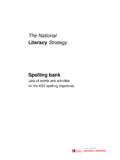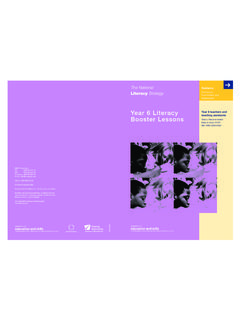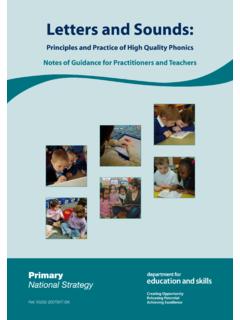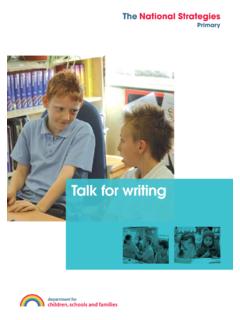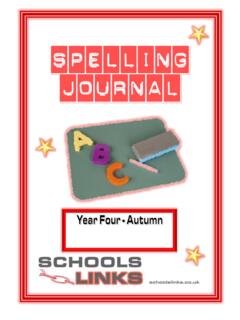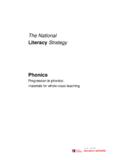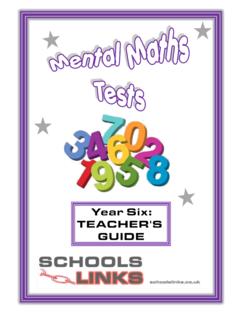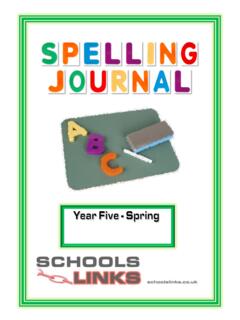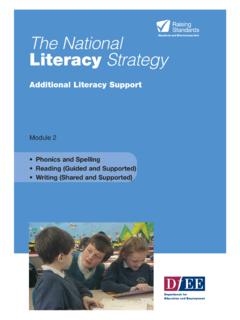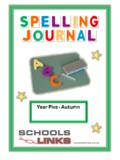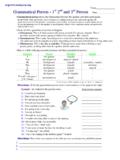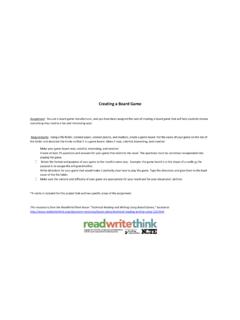Transcription of Headteachers & The National Teachers at KS2 Literacy ...
1 GuidanceCurriculum & StandardsHeadteachers & Teachers at KS2 Status: recommendedDate of issue: September 2000 Ref: DfEE 0107/2000 Department forEducation and EmploymentThe National LiteracyStrategyGrammar for WritingThe National LiteracyStrategyGrammar for writingDepartment for Education and EmploymentSanctuary BuildingsGreat Smith StreetLondon SW1P 3BT Crown copyright 2000 Extracts from this document may be reproduced for non-commercial educational or trainingpurposes on condition that the source is acknowledgedISBN 0 19 312401 7 Acknowledgements Professor Richard Hudson and Dr Catherine Walters for advice on grammatical content Macmillan Press Ltd for permission to reprint, in Teaching Unit 41, an extract from DennisFreeborn.
2 With Peter French and David Langford,Varieties of English: An Introduction to theStudy of Language(Macmillan Education, 1986)Introduction and rationaleContentsPart 1 Introduction and rationale7 Part 2: The teaching unitsHow to use the teaching units24 Year 333 Year 473 Year 5101 Year 6125 Part 31 Summary of organisation and language features: fiction and poetry1522 Summary of organisation and language features: non-fiction1543 Instructions for the generic sentence level activities 1564 Some grammatical terminology1625A teacher s description of a unit of work1646 The sequence of children s sentence level work and writing1667 Glossary 1768 Grammatical subject index216 Contents3 This book has a two-fold purpose: to provide lively whole class activities for teaching the Key Stage 2 sentence level objectives inthe National Literacy Strategy Framework for teaching.
3 To explain and illustrate the varied forms which shared writing can take as a powerful mediumfor teaching 1 Introduction and rationaleWe all use language to think and communicate. Language is systematically organised by itsgrammar which is inextricably linked to meaning and communication we cannot make sensewithout shaping grammatical and linguistic structures. All pupils have extensive grammaticalknowledge. Much of this is implicit, but they are able to generalise and improvise from thisknowledge. Teaching which focuses on grammar helps to make this knowledge explicit, extendchildren s range and develop more confident and versatile language guidance is designed to help Teachers teach writing.
4 It focuses on the teaching of the sentencelevel objectives in the National Literacy Strategy Framework for have called it Grammar for writing to emphasise the centrality of grammar in the teaching of writing. In the videoaccompanying Module 3 of the NLS 1998 training materials, Professor David Crystal explains theimportance of grammar: Grammar is what gives sense to language .. Sentences make words yield up their actively create sense in language and the business of the study of sentences is thestudy of grammar. Some would argue that the study of grammar is worth teaching in its own right because it isintrinsically interesting and so it is.
5 This is not the primary aim here; our aim is to improve children swriting. Grammar is fundamental to this, as a means to an end, but a means which involvesinvestigation, problem-solving, language play and a growing awareness of and interest in howlanguage works. This book focuses on the teaching of sentence level objectives in the Literacy Hourbut, throughout, the emphasis is on how children s growing understanding and use of grammarhelps them to write more should be clear from this that the purpose of teaching grammar is not simply the naming of partsof speech, nor is it to provide arbitrary rules for correct English. It is about making children aware ofkey grammatical principles and their effects, to increase the range of choices open to them whenthey learn grammar as an integral part of learning to speak from the earliest stages.
6 Thedevelopment of oral language is vitally important in its own right as well as being essential tosuccess in Literacy . In the course of development, children will use grammar in a wide variety ofways, often with considerable complexity. Very young children will imply meanings using singleIntroduction and rationale7words in a variety of grammatical ways. For example, a one-year-old saying Milk could mean:Look!There s some milk;Can I have more milk?;Is that one milk?etc., showing what they mean by tone ofvoice and/or gesture. Older children often use very complex grammatical constructions in speechwhich may not be appropriate as written forms.
7 Children frequently encounter very sophisticatedgrammar in the speech and writing of others which they understand without National Literacy Strategy sentence level teaching objectives are not intended to providedevelopmental descriptions of this kind. They focus on a limited but important range of skills thatchildren need for writing. They are about extending and making explicit aspects of children sintuitive knowledge of grammar, focusing on aspects of grammar which tend to distinguish writtenfrom spoken texts. The grammatical characteristics of spoken language are different in significantways from those of written language. These differences are related to the permanence of thewritten form, and the need to be concise and explicit, and because often the intended reader isseparated from the writer by time and space.
8 Whereas speakers often rely on context, facialexpression, intonation, pauses, etc. to convey meaning and create effect, writers often use moreexplicit grammatical structures as well as other organisational features, such as paragraphs,headings and sometimes diagrams, to communicate ideas. The following two texts illustrate someof the differences:AToday we learnt about taste and Miss Ward put some things out on the table and we had totaste them and what we had to do is they all had numbers by them and we had to taste themand it had a different taste to them and we had to taste them and see if it was sweet, salt, andbitter and sour and I did not taste any experimentWe had to taste foods which had different numbers to see if they tasted sweet, salt, bitter orsour.
9 I thought the best taste was cheese and the worst was pickle. I did not find anything these two examples, the intentions are similar: to explain the experiment. Text A recounts theevents but backtracks and repeats. When written down, these repetitions stand out but, whenspoken, they make sense. The speaker joins all the thoughts together with and and uses intonation,gesture and stress to keep the listener on track. Text B is more clearly a written recount. It containsfar fewer clauses than A and joins them in more complex ways, ie by subordination rather than thecontinuous use of the conjunction and . The effect is a more focused and free-standing accountwhich can be read by any growth of competence in writing also contributes importantly to the broader development ofchildren s thinking.
10 The more context-free and explicit nature of writing helps children becomeincreasingly reflective about language. By structuring and restructuring ideas in writing, childrenextend their powers of imagination, learn to express increasingly complex, abstract and logicalrelationships, develop skills of reasoning and critical evaluation. This, in turn, feeds back into theircompetence as thinkers and and rationale8It is instructive to look at the key messages about children s writing from the National tests derivedfrom analysis of a sample of scripts. These give a very clear indication of the writing skills thatchildren need to succeed in as they move through to their secondary education (Standards at KeyStage 2 English, Mathematics and Science.)
